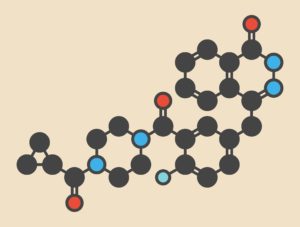Non-invasive PET imaging of PARP expression

The manipulation of the genomic instability of tumorous tissues proved to be an efficient anticancer therapeutic method. More specifically, inhibitors of poly(ADP-ribose) polymerases (PARP) enzymes have been a popular subject of study, being olaparib (Lymparza®) the first PARP inhibitor clinically approved.
A number of clinical trials currently studies the use of olaparib in diverse therapies; however, despite the considerable successes, resistance to PARP inhibition often occurs in patients due to occasional low PARP enzyme expression in tumours.
Positron emission tomography (PET) has emerged as a popular non-invasive evaluation method to reveal the PARP expression in tumours. Several radiolabelled olaparib analogues have been used in PET studies; however, their structural deviation from olaparib makes them incompatible for further development. Researchers at Oxford have tackled this limitation and developed the first [18F]-labelled olaparib, thus allowing in-vitro and in-vivo monitoring of olaparib accumulation in tumours.
PARP inhibitors in anticancer therapy
Tumorous tissues are characterised by having genomic instability due to replicative stress, external genotoxicity and DNA repair defects. The manipulation of such instability provides a therapeutic space in which inhibitors of DNA damage repair (DDR) enzymes have been studied as anti-cancer drugs. Poly (ADP-ribose) polymerase (PARP) are a class of DDR enzymes, and its inhibition has been the subject of numerous studies. The first clinically approved and most studied PARP inhibitor is olaparib (Lymparza®), currently present in a plethora of clinical trials focused on its use as a single drug, or in combination with chemo-, immuno-, or radiation therapy.
Despite the therapy being highly successful, resistance to PARP inhibition remains a current challenge when applying the therapy to patients. Among the causes, it was found that resistance is often due to low PARP enzyme expression. Consequently, methods to evaluate PARP expression status in tumours are critical; however, current approaches remain invasive and might not fully represent the heterogeneity of the sample.
Measurement of PARP expression
Positron emission tomography (PET) has become highly popular as an alternative method to measure PARP expression in vivo, as it allows for a non-invasive, whole-body and repeatable visualisation of olaparib delivery and binding to PARP. Several radiolabelled olaparib derivatives have been developed and applied in the understanding of DDR mechanism; however, their structural deviation from their parent molecule makes them unsuitable for further development.
[18F]olaparib for PET imaging
Oxford researchers have applied their expertise on novel radiofluorination methods and synthesised the first [18F]-labelled olaparib from a bench stable precursor. This “hot” compound has an identical structure to the unlabelled version meaning that better data can be gathered about the fate of olaparib in vivo compared to those labelled analogues which use large linker moieties or surrogates.
In vitro and in vivo translation of [18F]olaparib includes:
• Dynamic monitoring of bio-distribution and uptake
• Pharmacokinetics and clearance patterns studies
• Measurement of PARP binding
• Detection and monitoring of DNA damage
• Study of the relationship between hypoxia and PARP expression
In summary, [18F]olaparib was shown to be highly valuable in quantifying olaparib tumour accumulation both in vitro and in vivo, thus enforcing its translational use as a PARP imaging agent for clinical PET.
Protection and Applications
Oxford University Innovation is currently seeking a licensee to help commercialise the technology and has filed a UK priority patent application to protect this innovation.
about this technology

